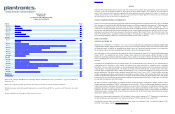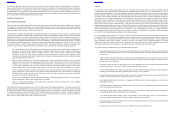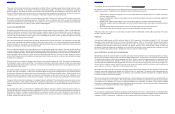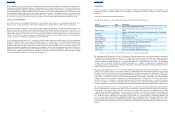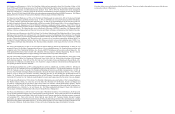Plantronics 2012 Annual Report Download - page 15
Download and view the complete annual report
Please find page 15 of the 2012 Plantronics annual report below. You can navigate through the pages in the report by either clicking on the pages listed below, or by using the keyword search tool below to find specific information within the annual report.
1918
The success of our products depends on several factors, including our ability to:
• anticipate technology and market trends;
• develop innovative new products and enhancements on a timely basis;
• distinguish our products from those of our competitors;
• create industrial designs that appeal to our customers and end-users;
• manufacture and deliver high-quality products in sufficient volumes and acceptable margins; and
• price our products competitively.
If we are unable to develop, manufacture, market and introduce enhanced or new products in a timely manner in response to
changing market conditions or customer requirements, including changing fashion trends and styles, it will materially adversely
affect our business, financial condition and results of operations. Furthermore, as we develop new generations of products more
quickly, we expect that the pace of product obsolescence will increase concurrently. The disposition of inventories of excess or
obsolete products may result in reductions to our operating margins and materially adversely affect our earnings and results of
operations.
We have significant foreign manufacturing operations and rely on third party manufacturers located outside the United States,
and a significant amount of our revenues are generated internationally, which subjects our business to risks of international
operations.
We have a manufacturing facility in Tijuana, Mexico. We also have suppliers and other vendors throughout Asia, including
GoerTek, Inc. located in Weifang, China, which is the manufacturer of the majority of our Bluetooth products. We also generate
a significant amount of our revenues from foreign customers.
The types of risks faced in connection with international operations and sales include, among others:
• fluctuations in foreign currency exchange rates;
• cultural differences in the conduct of business;
• greater difficulty in accounts receivable collection and longer collection periods;
• the impact of recessionary, volatile or adverse global economic conditions;
• reduced protection for intellectual property rights in some countries;
• unexpected changes in regulatory requirements;
• tariffs and other trade barriers;
• political conditions, health epidemics, civil unrest or criminal activities within each country;
• the management and operation of an enterprise spread over various countries;
• the burden and administrative costs of complying with a wide variety of foreign laws and regulations;
• currency restrictions; and
• compliance with anti-bribery laws, including, without limitation, compliance with the Foreign Corrupt Practices Act and
the United Kingdom's Bribery Act.
The above-listed and other inherent risks of international operations could materially adversely affect our business, financial
condition and results of operations.
We are exposed to fluctuations in foreign currency exchange rates which may adversely affect our revenues, gross profit, and
profitability.
Fluctuations in foreign currency exchange rates impact our revenues and profitability because we report our financial statements
in USD, whereas a significant portion of our sales to customers are transacted in other currencies, particularly the Euro and the
GBP. Furthermore, fluctuations in foreign currency rates impact our global pricing strategy resulting in our lowering or raising
selling prices in one or more currencies in order to avoid disparity with USD prices and to respond to currency-driven competitive
pricing actions. We also have significant manufacturing operations in Mexico and fluctuations in the Mexican Peso exchange rate
can impact our gross profit and profitability. Additionally, a large majority of our suppliers are located internationally, principally
in Asia. Accordingly, volatile or sustained increases or decreases in exchange rates of Asian currencies may result in increased
costs or reductions in the number of qualified suppliers.
Currency exchange rates are volatile, and while we hedge our major exposures, changes in exchange rates in the future may still
have a negative impact on our financial results. Among the factors that may affect currency values are trade balances, the level
of short-term interest rates, differences in relative values of similar assets in different currencies, long-term opportunities for
investment and capital appreciation, and political developments.
Table of Contents
We hedge a portion of our Euro and GBP forecasted revenue exposures for the future 12 month period. In addition, we hedge a
portion of our Mexican Peso forecasted cost of revenues. Although we have employed these hedging techniques to minimize
these risks, we can offer no assurance that such strategies will be effective. If the Euro and GBP fall against the USD, our revenues,
gross profit and profitability in the future could be negatively affected.
We also have foreign currency forward contracts denominated in Euros, GBP and Australian Dollars which hedge against a portion
of our foreign-currency denominated assets and liabilities. Our foreign currency forward contracts reduce, but do not eliminate,
the impact of currency exchange rate movements. For example, we do not execute forward contracts in all currencies in which
we conduct business.
We sell our products through various channels of distribution that can be volatile, and failure to establish and maintain
successful relationships with our channel partners could materially adversely affect our business, financial condition, or results
of operations. In addition, bankruptcies or financial difficulties of our customers may impact our business.
We sell substantially all of our products to end users through distributors, retailers, OEMs, and telephony service providers.
Effectively managing these relationships and avoiding channel conflicts can be difficult and time-consuming. Our existing
relationships with these parties are not exclusive and can be terminated by us or them without cause. In the future, we may not
be able to retain or attract a sufficient number of qualified distributors, retailers, OEMs, and telephony service providers. These
customers also sell or may sell products offered by our competitors. To the extent that our competitors offer these customers more
favorable terms or more compelling products, such customers may decline to carry, de-emphasize, or discontinue carrying our
products. Further, such customers may not recommend or may stop recommending our products. In the future, our OEMs or
potential OEMs may elect to manufacture their own products that are similar to those we currently sell to them. The inability to
establish or maintain successful relationships with distributors, OEMs, retailers and telephony service providers or to expand our
distribution channels could materially adversely affect our business, financial condition, or results of operations. We have
experienced the bankruptcy of certain customers; for example, in fiscal year 2012, the bankruptcy of one of our customers negatively
impacted our operating income by $1.2 million. It is not possible to predict whether additional bankruptcies may occur.
As a result of the evolution of our consumer business, our customer mix is changing, and certain retailers, OEMs, and wireless
carriers are more significant. This reliance on certain large channel partners could increase the volatility of our revenues and
earnings. In particular, we have several large customers whose order patterns are difficult to predict. Offers and promotions by
these customers may result in significant fluctuations of their purchasing activities over time. If we are unable to anticipate the
purchase requirements of these customers, our revenues may be adversely affected, or we may be exposed to large volumes of
inventory that cannot be resold to other customers.
Our corporate tax rate may increase, which could adversely impact our cash flow, financial condition and results of operations.
We have significant operations in various tax jurisdictions throughout the world, and a substantial portion of our taxable income
has been generated historically in jurisdictions outside of the U.S. Currently, some of our operations are taxed at rates substantially
lower than U.S. tax rates. If our income in these lower tax jurisdictions were no longer to qualify for these lower tax rates, the
applicable tax laws were rescinded or changed, or the mix of our earnings shifts from lower rate jurisdictions to higher rate
jurisdictions, our operating results could be materially adversely affected. If U.S. or other foreign tax authorities change applicable
tax laws or successfully challenge the manner in which our profits are currently recognized, our overall taxes could increase, and
our business, cash flow, financial condition, and results of operations could be materially adversely affected.
Our Board of Directors has authorized the repurchase of shares of our common stock to enhance stockholder value and may
do so again in the future. Stock repurchases may not result in enhanced stockholder value, may not prove to be the best use
of our cash resources and may require us to draw additional funds on our existing credit agreement.
On March 8, 2012, we announced the completion of a 7,000,000 share repurchase program initially authorized by our Board of
Directors in May 2011. We further announced that our Board of Directors had authorized an additional 1,000,000 share repurchase
program. There can be no assurance that our stock repurchase programs will have a beneficial impact on our stock price or if our
Board of Directors will authorize additional stock repurchase programs in the future. Additionally, the timing of our stock
repurchases varies with fluctuations in the trading price of our common stock such that at any particular time our domestic cash
flow from operations has been, and may be again in the future, insufficient to fully cover our stock repurchases and support our
working capital needs. In May 2011 we entered into a credit agreement (“Credit Agreement”) with Wells Fargo Bank, National
Association which provides for a $100 million unsecured revolving credit facility. We have previously drawn funds and expect
to continue drawing funds under the Credit Agreement from time to time, which amounts bear interest. Moreover, the Credit
Agreement contains affirmative and negative covenants with which we must comply. These restrictions apply regardless of whether
any loans are outstanding and could adversely impact how we operate our business.
Table of Contents



